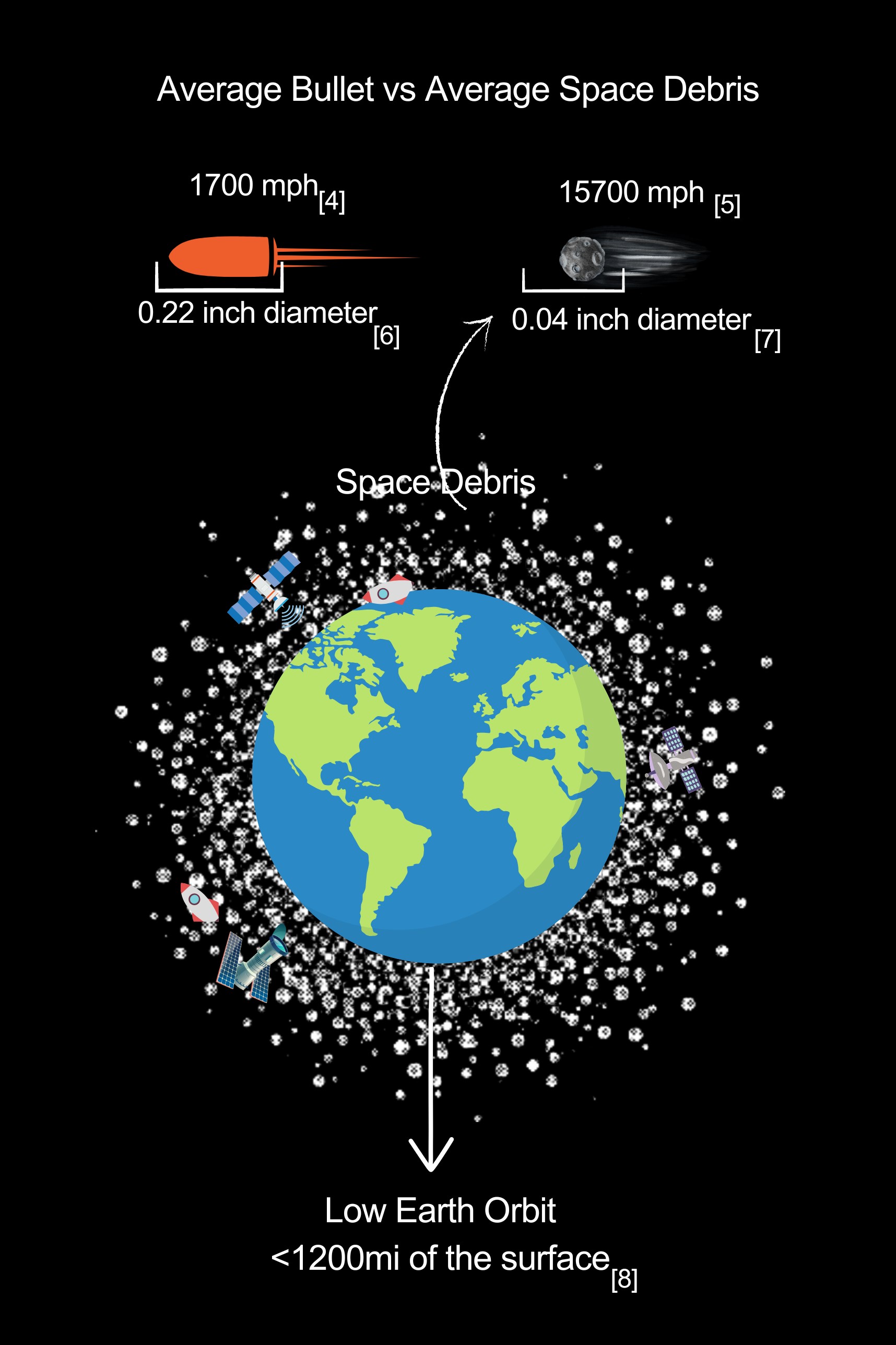Amidst the vast expanse of space, an invisible threat looms closer to our planet than many might realize. Over 100 million pieces of space debris — which include defunct satellites, spent rocket stages, small meteoroids, and fragments from disintegration, erosion, and collisions — clutter the near-Earth space. Shockingly, only 27,000 of these fragments are actively monitored by the Department of Defense's global Space Surveillance Network (SSN) sensors (Dunbar, 2021).
Now, consider a piece of untracked debris hurtling through space at an average speed of 15,700 miles per hour, a common velocity for objects in low Earth orbit (Dunbar, 2021). Should it collide with a satellite or spacecraft, the results could be catastrophic. At these high velocities, even small fragments possess immense kinetic energy. A collision with an active satellite can disrupt communication networks, impact weather forecasting, hinder navigation systems, and interfere with Earth monitoring capabilities (Muelhaupt, 2015, p. 2).

Worse, these collisions can usher in the terrifying Kessler Syndrome. Proposed by NASA scientist Donald J. Kessler in 1978, this theory describes a tipping point where space debris becomes so dense that one collision leads to a cascade of further collisions (Peralta, 2011). Such a chain reaction could shroud our planet in an almost impenetrable barrier of debris, making any further space missions and satellite operations prohibitively treacherous.
But there's hope on the horizon. Several ongoing efforts use collision monitoring and avoidance technologies to attempt to prevent this cascade. Global collaborative frameworks like the Space Data Association (SDA) are using collaborative, global surveillance efforts to provide real-time data on satellite movements and potential debris threats (Space Data Association, n.d.). This information is widely disseminated, promoting shared responsibility and a more proactive approach to debris management. Similarly, LeoLabs proactively deals with threats through “space traffic” management. They leverage state-of-the-art algorithms to devise collision prediction models (eoPortal Directory, 2021). With such tools in play, satellites can autonomously reroute their trajectories, dodging incoming debris and evading potential collisions — a crucial step in halting the accumulation of space debris.
Additionally, researchers are developing satellite materials that disintegrate efficiently upon atmospheric re-entry. Space agencies are prioritizing designs utilizing dragsails and space tethers while minimizing the use of external components, which could potentially become detached and add to the debris problem (NASA, 2007). These innovative technologies present an ecologically-friendly solution to debris mitigation. Electrodynamic tethers or “space tethers” harness electromagnetic interactions with the Earth's magnetic field to generate thrust, facilitating controlled deorbiting (Gallagher, Johnson, Moore, & Bagenal, 1998, p.1). Dragsails, on the other hand, increase a satellite's atmospheric drag, ensuring a methodical, fuel-free descent and burn-up, thus leaving no residual debris (Rhatigan & Lan, 2019).
In the meantime, pioneer projects like NASA's Restore-L and DARPA's Robotic Servicing of Geosynchronous Satellites (RSGS) are innovating for longer lasting satellites. These initiatives offer in-situ satellite servicing, refueling, repairs, and upgrades (Saplan, n.d.; Alessandro, 2016). This can extend satellite operational life, reducing the frequency of replacements and, consequently, slowing the addition of debris to the orbital environment.
To combat the growing threat of space debris, humanity must transition from mere orbital exploration to responsible “orbital stewardship.” Our response now determines our legacy: will we be celebrated as astral pioneers, or will we be remembered as no more than cosmic litterbugs?
References
Dunbar, B. (2021, May 26). Space Debris and Human Spacecraft. NASA. https://www.nasa.gov/mission_pages/station/news/orbital_debris.html.
Muelhaupt, T. (2015, Fall). Space Debris and The Aerospace Corporation. Understanding Space Debris: Causes, Mitigations, and Issues. Crosslink. https://aerospace.org/sites/default/files/2019-04/Crosslink%20Fall%202015%20V16N1%20.pdf.
Tanwar, S. (2019, Dec 16). How Fast Does a Bullet Travel? Medium. https://medium.com/science-widget/how-fast-does-a-bullet-travel-d42e3d616692.
Pistol Basics 101. Calibers & Bullets 101. https://www.pistolbasics101.com/calibers--bullets-101.html.
Dunbar, B. (2022, February 18). Low-Earth Orbit Economy FAQs. NASA. https://www.nasa.gov/leo-economy/faqs.
Peralta, E. (2011, September 1). Study: Space Debris Has Reached A Tipping Point. NPR. https://www.npr.org/sections/thetwo-way/2011/09/01/140114894/study-space-debris-has-reached-a-tipping-point.
Space Data Association. Space Data Association. https://www.space-data.org/sda/.
eoPortal Directory. (2021, June 22). LeoLabs. https://www.eoportal.org/other-space-activities/leolabs.
NASA. (2007, November 30). Tethered Spacecraft to Be Used Like a Yo-Yo. https://www.nasa.gov/vision/universe/roboticexplorers/tethered_spacecraft.html.
Gallagher, D. L., Johnson, L., Moore, J., & Bagenal, F. (1998). Electrodynamic Tether Propulsion and Power Generation at Jupiter (NASA/TP-1998-208475). NASA Marshall Space Flight Center. https://ntrs.nasa.gov/citations/19980203952
Rhatigan, J. L., & Lan, W. (2019). Drag-enhancing deorbit devices for spacecraft self-disposal: A review of progress and opportunities. First International Orbital Debris Conference, 6-7. https://www.hou.usra.edu/meetings/orbitaldebris2019/orbital2019paper/pdf/6124.pdf.
Saplan, A. (n.d.). Robotic Servicing of Geosynchronous Satellites. Defense Advanced Research Projects Agency. https://www.darpa.mil/program/robotic-servicing-of-geosynchronous-satellites.
Alessandro, A. (2016, June 23). NASA's Restore-L Mission to Refuel Landsat 7, Demonstrate Crosscutting Technologies. NASA. https://www.nasa.gov/feature/nasa-s-restore-l-mission-to-refuel-landsat-7-demonstrate-crosscutting-technologies.
